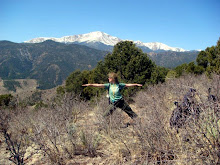
I mentioned in my last post that I'd had a visceral negative reaction to Sedona -- undeniably one of the most beautiful places on earth -- which surprised and dismayed me. I had a vague sense that I was offended by the opulence and pseudo-spiritualism of the place, but that didn't completely explain my snarky attitude which, I've come to understand, usually masks a deeper response to perceived injustice or dashed hopes.
I found an answer in the form of a book I happened to pull from my brother's bookshelf: An American Child Supreme -- the education of a liberation ecologist, by John Nichols. It's a memoir of sorts, and tries to decipher how any of us -- born into a culture that very nearly ensures that we become bigots, greedy consumers, warmongers, and environmental parasites -- develops a social conscience.
John Nichols tells of the life-changing -- often seemingly innocuous -- events, people and books that transformed him from a product of a privileged upbringing and Mayflower pedigree to a liberation ecologist (as opposed to naturalist or environmentalist), a more radical superstratum of social ecology.
I won't go into any of that, although it was fascinating to me. I'll just write the words that I scratched frantically into my little notebook so I'd not lose them or allow myself to forget them. I wasn't sure how they related to Sedona, but somehow they did.
Myself, I do not have the courage or the fanaticism that motivated Diana Oughton (of the Weather Underground) to build bombs, but I cannot envision the changes we need without some sort of apocalyptic reaction against the current levels of violence generated by the daily economic activities of the multinationals that feed and clothe us.
Territorial shooting wars are only a small fraction of the greater (and more horrific) violence of a world market that levels forests, pollutes the oceans, impoverishes people and toxifies topsoil in order to bring us our hamburgers, polyester golf slacks, and Marlboro cigarettes. "The human murder by poverty in Latin America is secret," writes Eduard Galeano. "Every year, without making a sound, three Hiroshima bombs explode over communities that have become accustomed to suffering with clenched teeth. This systemic violence is not apparent but is real and constantly increasing: its holocausts are not made known in the sensational press but in Food and Agricultural Organization statistics."
Environmental collapse is now universally caused by monopoly capital plundering earth's biological and human resources for profit. The profit is generated by the labor of those underdogs, whose energy is thus co-opted to destroy the environment. This means that our most destructive environmental problems are tied to their inequality. . . . That inequality is causing a downward social spiral on earth and eco-devastation. Profit requires demolition. The racism that deforms our nation (and the globe) is a tool used by a capitalist society to maintain class divisions for profit-making reasons, so racism is also a main component of biosystem toxicity.
John Nichols sums up the philosophy of a liberation ecologist when he quotes Tom Athanasiou's book Divided Planet: The Ecology of Rich and Poor, whose words are directed at environmentalists:
"The time for such political innocence is over. . . .it is past time for environmentalists to face their own history, in which they have too often stood not for justice and freedom, or even for realism, but merely for the comforts and aesthetics of affluent nature lovers. They have no choice. History will judge greens by whether they stand with the world's poor."
That must be it. I distrusted Sedona because it quite obviously doesn't stand with the world's poor, nor even the nation's middle class. It is an enclave for affluent nature lovers whose social consciences are buried in crystals and energy forces, $4 iced teas and expensive gauzy skirts.
Sedona seems to care not a whit about social or economic justice nor -- I'd wager a guess -- about wreaking environmental havoc in Utah and New Mexico to keep its own little slice of Eden energized and enflowered. There is no need for Sedona to worry about the larger world, neither liberation for its people nor the sustainability of its global environment. Sedona exists unto itself and its wealthy denizens -- to be owned, developed and distributed and enjoyed at their directive.
Saturday, May 9, 2009
Phony Sedon-y
Posted by
Marie Walden
at
11:50 PM
![]()
Labels: Environment, Spirituality, Travel
Subscribe to:
Post Comments (Atom)


No comments:
Post a Comment